- Home
- Soil Testing Equipment
Soil Testing Equipment
The liquid limit, defined as the moisture content at which the soil passes from the plastic state to the liquid state, is very helpful in the classification of the potential properties of the soil material. The liquid limit gives a measure of the shearing resistance which a soil has when mixed with water. Casagrande Method or Cone Penetrometer Method can determine the liquid limit of soil.
Meets: - BIS 2720
Shiva scientific Instruments offers the following models
- Liquid Limit Device complete with Casagrande's grooving tool and
gauge block
The Liquid Limit Device consists of a hard rubber base carrying a sliding carriage assembly to which a brass cup is hinged. The cup is raised and allowed to fall through a height of 1 cm on to the hard rubber base, by the help of a lead screw provided at the back of the sliding carriage. Supplied complete with Casagrande Grooving Tool and Gauge Block - Liquid Limit Device complete with Casagrande's grooving tool, gauge block and Counter
- Liquid Limit Device, Motorised, complete with Casagrande's
grooving tool, gauge block and Counter
The Liquid Limit Device consists of a hard rubber base carrying a sliding carriage assembly to which a brass cup is hinged. The cup is raised and allowed to fall through a height of 1 cm on to the hard rubber base, by the help of of electric motor which operates on 220 Volts 50 Hz. and also lead screw provided at the back of the sliding carriage Supplied complete with Casagrande Grooving Tool and Gauge Block
Proctor Compaction Apparatus

Proctor Compaction Apparatus
Meets: - IS: 2720 (Part 7)-1987, IS: 2720 (Part 8)-1990, IS: 9198- 1979, IS: 10074-1982, BS: 1377
We offer two types of modals as follows .
- Compaction Test Apparatus Having 2.86 Kg Rammer X 300 MM Fall (Light Compaction Test)
- Compaction Test Apparatus Having 4.89 Kg Rammer X 450 MM Fall (Heavy Compaction Test.)
Consolidation single cell

Consolidation
Meets: - IS: 2720 (Part 15) 1986, IS: 12287-1988, BS: 1377, ASTM D2435
Consolidation Apparatus
Direct Shear Apparatus Manual

Direct Shear Apparatus
- Loading Unit Vertical load, capacity 8 kg/sq. cm. Load is applied either directly or through a counter balanced detachable lever. Provision is made for the load to be applied either through a steel ball recessed in the loading pad or directly through a boss on the loading yoke.
- Shear load capacity 400 kg.
- Direct shear box for square specimen size 60 x 60 x 25 mm complete with one base plate, two plain gripper plates, two perforated gripper plates, porous stones and one loading Pad. Shear box housing, complete with two ball roller strips. Specimen cutter for 60 x 60 x 25 mm specimens.
- For shear load measurement : Capacity 400 kg. Consolidation dial gauge .01 mm, One no. Strain dial gauge .01 mm, One no.
Meets:- IS: 2720 (Part 13), ASTM D 3080, IS: 2720 (Section 1 - Part 39),IS: 11593-1986, IS: 11229 - 1985, 2720 (Part 13) - 1986
- Direct Shear apparatus, 2 KN Manual
Specimen Size: 60 x 60 x 25 mm - Direct Shear apparatus, 2 KN Motorised
Rates of Strain (mm/min): 1.25,
Specimen Size: 60 x 60 x 25 mm
Power Specifications: 230 V, 50 Hz, Single Phase, AC supply - Direct Shear apparatus, 2 KN, Motorised with Digital Readout
Read Out: Digital Rates of Strain (mm/min): 1.25,
Specimen Size: 60 x 60 x 25 mm
Power Specifications: 230 V, 50 Hz, Single Phase, AC supply
Dynamic Cone Penetrometer
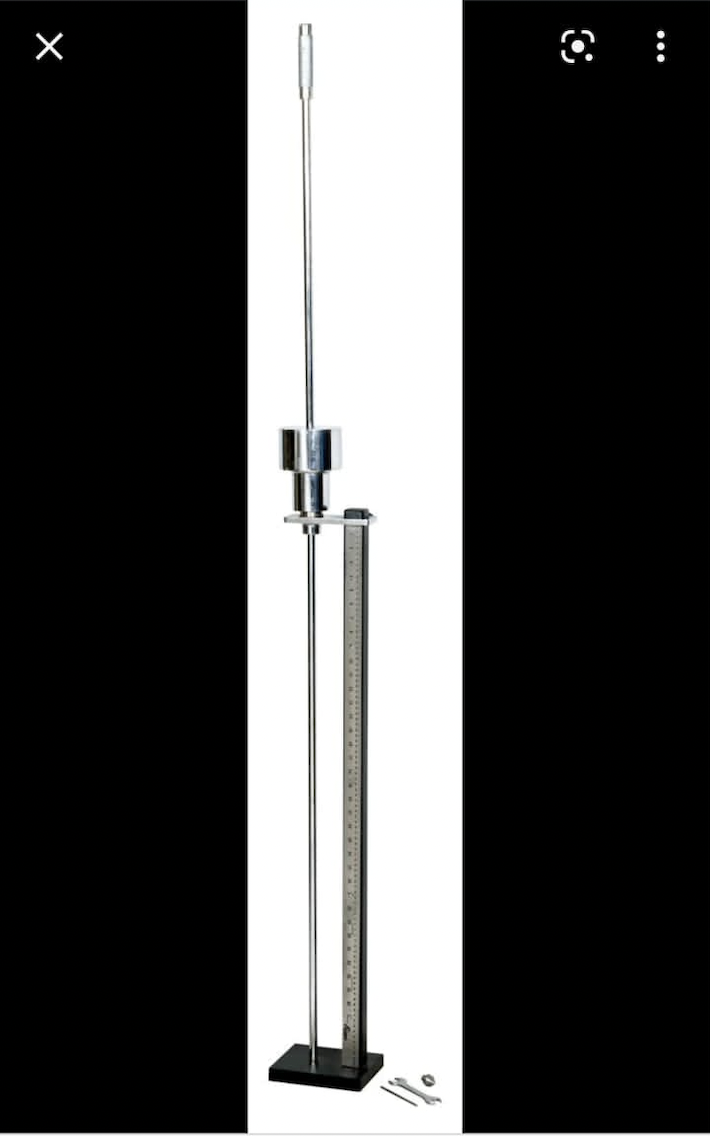
Dynamic Cone Penetrometer
- Cone Plain 50mm base dia and cone angle 60 deg.
- Cone adaptor with cone and standard threads for 'A' rod coupling.
- Cone threaded for 'A' rod coupling 60 deg. cone angle, 50mm base dia.
California Bearing Ratio Test Apparatus

Laboratory California Bearing Ratio Test Apparatus, Motorised
Available in-Hand Operated, three speed, six speed, twelve speed and thirty speed.
The apparatus consists of
- Mould, 150 mm ID x 175 mm high M. steel
- Metal Tripod, for Dial Gauge
- Penetration Piston, 50 mm face dia
- Circular Metal Spacer Disc, with detachable handle, 148 mm dia x 47.7 mm height
- Perforated Plate, 148 mm dia, with adjustable Stem and Lock Nut
- Soaking Tank for six CBR mould
- Extension Collar, 150 mm ID x 50 mm high
- Annular Metal Weight, 2.5 kg, 147 mm dia with 53 mm dia central hole
- Slotted Metal Weight, 2.5 kg, 147 mm dia, with 53 mm dia slot
- Swell Plate
- Cutting Collar
Automatic Cone Penetrometer

Automatic Cone Penetrometer
Available in-Hand Operated, three speed, six speed, twelve speed and thirty speed.
The apparatus consists of
- Mould, 150 mm ID x 175 mm high M. steel
- Metal Tripod, for Dial Gauge
- Penetration Piston, 50 mm face dia
- Circular Metal Spacer Disc, with detachable handle, 148 mm dia x 47.7 mm height
- Perforated Plate, 148 mm dia, with adjustable Stem and Lock Nut
- Soaking Tank for six CBR mould
- Extension Collar, 150 mm ID x 50 mm high
- Annular Metal Weight, 2.5 kg, 147 mm dia with 53 mm dia central hole
- Slotted Metal Weight, 2.5 kg, 147 mm dia, with 53 mm dia slot
- Swell Plate
- Cutting Collar
Multi speed Universal Load frame

Multi speed Universal Load frame 50 KN
- Speed Rate: - 0.1 mm/min to 60 mm/min.
- Max. Load: - 50 KN
- Speed Rotating As Per IS Standards
It can be use for the following tests
- Triaxial Test for soil.
- Unconfined test for soil.
- CBR test for soil.
- Marshall test of Bituminous Products
- Duriez test of Bituminous Products.
- Indirect Tensile of Bituminous Products.
Note: - Data logger can also be supplied for recoding the stain and displacements
Soil Permeability Apparatus
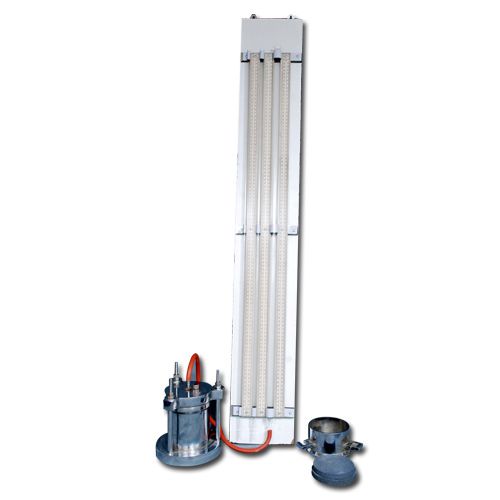
Soil Permeability Apparatus
The equipment comprises the following :
- Metallic mould, 100 mm dia x 127.3 high x 1000 ml volume.
- Extension collar, 100 mm dia x 60 mm high
- Drainage base plate with a recess for a porous stone and with an outlet valve.
- Metallic clamping ring.
- Drainage cap (Top plate with a recess for a porous stone and fitted with an inlet valve and an air release valve).
- Dummy plate to serve as a false bottom during compaction.
- Porous stone for drainage cap.
- Set of three glass stand pipes approximately 6 mm dia, 10 mm dia and 20 mm dia mounted on a wooden board.
- Length of three meter long rubber connecting tube with a pinch cock.
- Overhead tank made of steel, approximately 37.5 cm dia x 1 meter high. It is provided with an inlet port at the top and six out let at bottom with cocks and air inlet and water filling tube on top. An arrangement is provided to indicate the water level.
Pycnometer

Pycnometer
Meets: - IS: 2386 (Part 3)-1963
Sample Extractors
- Sample Extractor, Hand Operated, for 38 mm
This extruder is used for taking sample core specimens of 38 mm dia from sampling tube the outfit by the Screw Type method with a Wire Sample Trimmer - Sample Extractor, Hand operated, universal
This extruder is used for taking sample core specimens of 38 mm, 50 mm, 75 mm and 100 mm dia from sampling tube - Sample Extractor, motorised. All purpose Hydraulic Extruder
This Extractor has been specially designed to overcome the difficulties faced in extracting specimens from long sampling tubes. Provided with Power pack with quick release coupling and having Manual operation possible on power failure Eject soil from sampling tubes and moulds up to 60 cm in length and 38mm to 150mm in dia by a single operation. Allows direct transfer of soil from field sampling tubes, proctor and CBR moulds into 38mm dia tubes with minimal disturbance
Sample Extruder, Hand operated
Sample Extruder Hydraulic four Motorized
Sampling Auger Outfits

Sampling Auger Outfits
- Sampling Auger Outfit, Blade Type, 75 mm dia
- Sampling Auger Outfit, Blade Type, 100 mm dia
- Sampling Auger Outfit, Blade Type, 150 mm dia
Meets:-ASTM D 1452
Undisturbed Samplers
Undisturbed Samplers
- Sampling Tube
38mm dia x 150mm long unrelieved. - Sampling tube
38mm dia x 200mm long unrelieved.
Sand Pouring Cylinder

Sand Pouring Cylinder Apparatus
Meets:- IS: 2720 (Part 28)
- Sand Pouring Cylinder Apparatus 100mm Dia.
- Sand Pouring Cylinder Apparatus 150mm Dia.
- Sand Pouring Cylinder Apparatus 200mm Dia.
Optional Extra Metal Tray without central hole
Triaxial Cell

Triaxial Cells
- Cell pressure
- Pore water pressure
- Drainage or backpressure
Triaxial Cell, Stationary Bushing. For universal 100mm dia
For testing the specimen of 38mm, 50mm, 75 mm, and 100mm. It consist of perspex chamber with anvil and loading plunger
Triaxial Cell, Stationary Bushing
For testing specimen of size 38mm dia X 76mm long
Triaxial Test Outfit (complete unit)
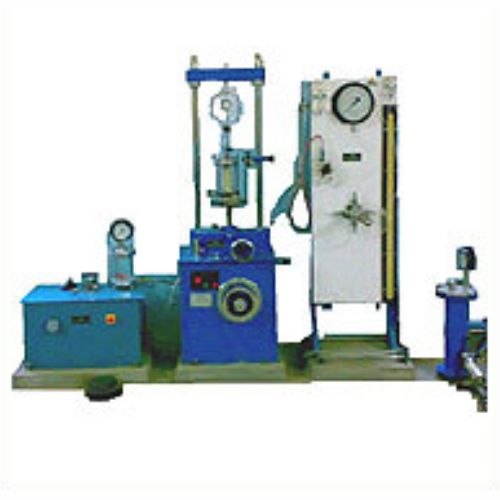
Triaxial Test Outfit (complete unit)
It consists of Load frame, Motorised, 50KN capacity and 30 speeds, two speeds constant strains, screw jack type, Triaxial cell Stationary bushing accommodating universal type dia. sample. Lateral Pressure Assembly, (Pressure Chamber with foot pump) capacity 10kg/cm sq. volume change gauge Proving Ring with Integral Boss, high sensitivity type, Dial gauge 0.01 X 25mm for strain measurement. Constant Pressure System 20Bar (20kg/cm sq)
Triaxial Test Outfit, Digital
Same as above with Digital Indicator
Sand Pouring Cylinder

Sand Pouring Cylinder Apparatus
Meets:- IS: 2720 (Part 28)
- Sand Pouring Cylinder Apparatus 100mm Dia.
- Sand Pouring Cylinder Apparatus 150mm Dia.
- Sand Pouring Cylinder Apparatus 200mm Dia.
Optional Extra Metal Tray without central hole
Triaxial Test Outfit

Triaxial Test Outfit (complete unit)
It consists of Load frame, Motorised, 50KN capacity and 30 speeds, two speeds constant strains, screw jack type, Triaxial cell Stationary bushing accommodating universal type dia. sample. Lateral Pressure Assembly, (Pressure Chamber with foot pump) capacity 10kg/cm sq. volume change gauge Proving Ring with Integral Boss, high sensitivity type, Dial gauge 0.01 X 25mm for strain measurement. Constant Pressure System 20Bar (20kg/cm sq)
Triaxial Test Outfit, Digital
Same as above with Digital Indicator
Pore Pressure Apparatus
Pore Pressure
The following models of Pore Pressure Apparatus are available:
1. Pore Pressure Apparatus, 1000 kPa (10 kg/cm2) Capacity
The equipment consists of:
- Pressure Gauge, Bourdon Tube Type, Graduation: -1.0 to +10 bar in 0.1 bar division (or -100 to +1,000 kPa in 10 kPa divisions) Dia: 200 mm
- Manometer, Glass U Tube, measures low positive and negative pore pressure and checks zero error of pressure gauge. It is provided with a mercury trap. (Mercury supplied at extra cost)
- Null Indicator, Perspex with mercury trap and cursor to indicate the mercury level
- Burette, 50 ml, for measurement of volume change in the soil specimen
- Pressure Pump, fitted with four Ball Valves
- Copper Coil
- Water Reservoir
2. Pore Pressure Apparatus, 2000 kPa (20 kg/cm2) capacity
Sensitive Volume Change Gauge
Sensitive Volume Change Gauge
The sensitive volume change gauge has realized sensitivity of 0.003 ml/mm with the 6 ml volume of fluid per cycle. The apparatus consists of a volume measuring polythene tube running along both sides of a scale and connected at both ends to two mercury traps. These traps are connected to flow reversal valves through a manifold. The length of the polythene tube is enough to measure 6 ml volume of fluid per cycle. A small pallet of mercury is introduced in the circuit to be used as a cursor, and the movement of pallet is measured. The unit is tested to a pressure of 20bar (20 kg/cm2) and is designed for wall mounting.
Test Sieve Analysis

Test Sieve Analysis
Perforated Steel Plate Square Hole Coarse Test Sieves
Aprature in MM
125mm, 106mm, 100mm, 90mm, 80mm, 75mm, 63mm, 53mm, 50mm, 45mm, 40mm, 37.5mm, 31.5mm, 26.5mm, 25mm, 22.4mm, 20mm, 19mm, 16mm, 13.2mm, 12.5mm, 11.2mm, 10mm, 9.5mm, 8mm, 6.7mm, 6.3mm, 5.6mm, 4.75mm.
20cm. dia Brass Frame without joint. All coarse series as detailed above.
30cm. dia G.I. Sheet Frame with joint-All coarse Series as detailed above.
45cm. dia G.I. Sheet Frame with joint-All coarse Series as detailed above.
Lid and Pan Sets 20cm. dia Brass, 30cm. dia G.I. Sheet, 45cm. dia G.I. Sheet
Test Sieves 20 cm Dia Fine Series
Sieve Shaker Gyratory Type

Sieve Shaker (Gyratory Type)
Suitable for operation on 230 volts, 50 cycles, single phase, A.C. supply. Supplied without sieves.
Accessories And Spares
- Adaptor for 12 inch diameter sieves.
- Time switch 0-60 minutes.
- Digital timer 0-99min.
Sieve Shaker Gyratory Type
Sieve Shaker (Rotap Type)
Wet Sieve Shaker (Yoder Type)
Rotap Sieve Shaker
Wet Sieve Shaker
Infra-Red Moisture Meter
Infra-Red Moisture Meter
- Capacity: 5 g approx.
- Sensitivity: 10 mg approx
Meets:- IS: 2720 (Part 2) - 1973
Optional Extras Infra Red Lamp
Thermometer
Torsion Wire, pack of six
Speedy Moisture Meter

Speedy Moisture Meter
Meets: - IS: 2720 (Part 2) - 1973 IS: 12175-1987
- Speedy Moisture Meter
Range: 0 - 25%, Accuracy Division: 1% - Speedy Moisture Meter
Range: 0 - 50%, Accuracy Division: 1%
Each instruments is supplied complete in a carrying case fitted with counterpoised balance for weighing the sample, Scoop for measuring carbide reagent, a set of steel balls and a cleaning brush.
Extra
Calcium Carbide Reagent, in a container of 500 gm
Swell Test Apparatus Manual
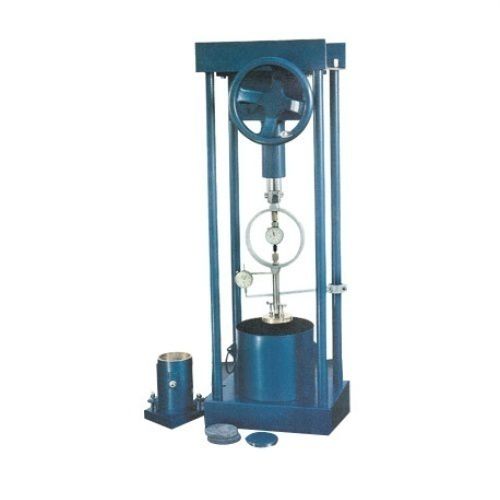
Swell Test Apparatus Manual
It consist of the following
- Capacity 50 kN (5,000kgf)
- Mould, 100 mm dia x 127.3 mm height (1,000 ml volume) with base plate and collar
- Proving Ring, with integral boss, high sensitivity 2.5 kN (250 kgf) capacity, with calibration chart
- Dial Gauge, 25 mm travel, 0.01 mm least count
- Perforated Swell Plate, 100 mm dia x 16 mm thick
- Spacer, 100 mm dia x 12.7 mm thick
- Pair of Porous Stones, 100 mm dia x 12.7 mm thick
- Load Transfer Bar
- Steel Ball
- Soaking Tank250 mm dia x 210 mm high
Laboratory Vane Shear Apparatus

Laboratory Vane Shear Apparatus
Meets:-IS: 2720 (Part 30)-1980
We have the following options.
- Laboratory Vane Shear Apparatus Motorised.
Rate of rotation: 1/60 rpm, operates on 230, 50 Hz, Single Phase, AC supply Supplied complete with Container 1 No. Set of 3 Springs, each of capacity 2 kg-cm, 4 kg-cm and 8 kg-cm, 2 Sets (complete with a wooden carrying case)
Extra Stand, for use at the site - Vane Shear Apparatus, Laboratory, manual
Same as above but operation is manual - In-situ Vane Shear Apparatus,
Capacity 2000kg, gear type
Plate Bearing Capacity
Plate Bearing Capacity, with 30, 45, 60 cm sqr. Chequered plates and accessories
- Load Truss 200kN (20,000 kgf)
- Load Truss 300kN (30,000 kgf)
- Load Truss 500kN (50,000 kgf)
Unconfined Compression Testing Machine
Unconfined Compression Testing Machine
- Unconfined Compression Testing Machine, Manual
Unconfined Compression Testing of soil is a quick and simple method to study the behaviour of soil. This is generally done on cohesive soils. In this test, specimen is subjected to uniaxial compression without any lateral support. The equipment can be used for determining the unconfined compression strength of cohesive soil specimens of 38mm, 50mm, 75mm and 100mm dia size.
The equipment comprises of the following- One loading unit, 50 kN (5000 kgf) capacity with three rates of travel.
- One top platen with spring and ball seat arrangement
- One bracket: for dial gauge mounting
- One adaptor for proving ring
- One extra plate for lower platen
- One spanner
- Unconfined Compression Testing Machine, Motorised
The Compression Testing is suitable for operation on 220 volts, 50 Hz., Single Phase, AC Supply. - Unconfined Compression Testing Machine, Motorised, Digital
Same as above but with Digital read out
Grain Size Analysis
Grain Size Analysis (Pipette Method)
This is for the determination of the sub sieve particle distribution in a soil sample by mechanical analysis. An analysis of this kind expresses quantity the proportions by weight of the various sizes of particles present in the soil. It is recommended as a standard procedure to use dispersion agent to avoid flocculation. The apparatus consists of a sliding panel which moves up and down by means of a screw allowing Anderson pipette fixed to it to be raised or lowered vertically. A sedimentation tube is held by a laboratory clamp provided on the stand below the pipette. The depth of immersion is measured by a scale graduated in mm at the side of the sliding panel. Supplied complete with Anderson pipette 10ml. At the side capacity made from glass, and a sedimentation tube also of glass of 500ml capacity and 50nos. Test form pads.
Soil Lathe Motorised
Soil Lathe Motorised
Shrinkage Limit Apparatus
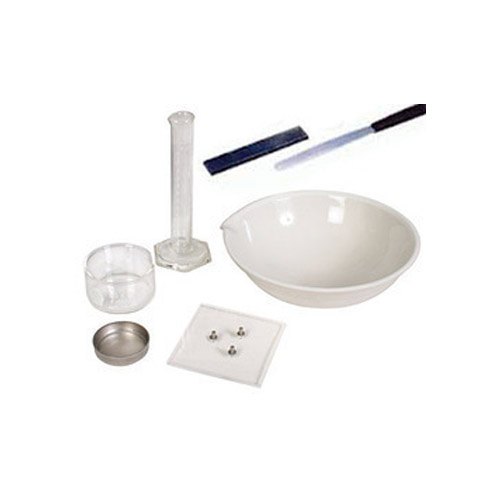
Shrinkage Limit Apparatus
Set consists of one each
- Porcelain evaporating Dish
- Shrinkage Dish
- Glass Cup
- Perspex plate with three metal prongs
- Perspex plate.
- Flexible spatula
- Glass cylinder 25ml x 0.5mlsupplied without mercury.
Proving Rings

Proving Rings
Generally the capacity of proving ring (compression and tension-compression) is 5KN (500 kgf). The loading bosses have female threading ½ inches B.S.F. Tension-compression rings have their integral loading bosses male threaded, ¼ inches diameter capacity are provided for use when loading in compression.
If our client wants we calibrate it ourselves and if required by our party we can make arrangement of calibration from Government Test House.